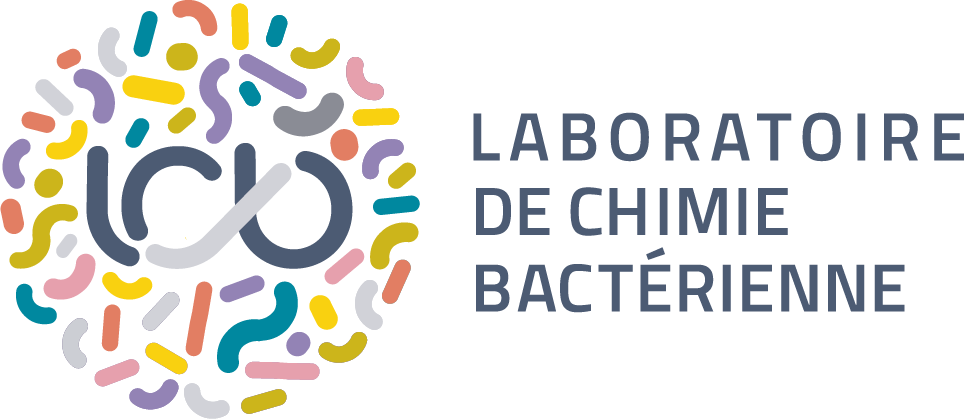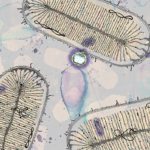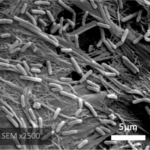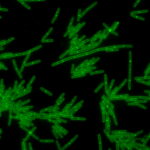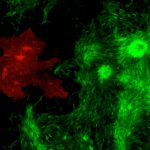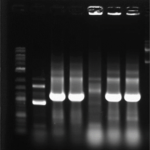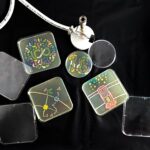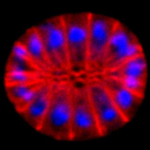Les axes de recherche
Axe 1
Cell biology of bacterial mobility
Cell biology of bacterial mobility
Axe 1
Alphaproteobacteria is a class of gram negarives with remarkable characteristics. They often interact with or infect plants and animals. An alphaproteobacterium was the ancestor of mitochondria and a bacterium of this class is the most abundant species in the oceans.
Moreover alphaproteobacteria often undergo to cellular differentiation and present a refultation of cell cylcle (coordination between DNA , logic and principles of cell cycle regulation and asymmetrical cell division in two well-known model systems, Caulobacter crescentus and Sinorhizobioum meliloti (see figure).
In caulobacter crescentus, CtrA (response regulator of Two-Component systems) controls many important functions (motility, DNA methylation, cell division, chemotaxis, stalk and pili biogenesis) and blocks directly the origin of DNA replication. In our lab we investigate the mechanisms of CtrA phosphorylation by CckA and ChpT (Biondi et al…, 2006, Nature) which is blocked by the DivJ-(PleC)-DivK module and c-di-GMP. We also investigate the regulation of trasncription by CcrM-dependent genome methylation and GcrA (Fioravanti et al., 2013, PLOS Genetics). In Sinorhizobium CtrA also controls cell cycle but it also involved in nitrogen-fixing bacteroids differentiation (Pini et al., 2013, Mol Micro ; Pini et al., 2015, PLOS Genetics).
Fig 2
SINORHIZOBIUM MELITOTI
An alphaproteobacterium was the ancestor of mitochondria and a bacterium of this class is the most abundant species in the oceans.


Process des étapes de recherche
Étape 1
Cell cycle regulation AlphaproteobacteriaÉtape 2
Cell cycle regulation AlphaproteobacteriaÉtape 3
Cell cycle regulation AlphaproteobacteriaÉtape 4
Cell cycle regulation AlphaproteobacteriaÉtape 5
Cell cycle regulation AlphaproteobacteriaÉtape 6
Cell cycle regulation AlphaproteobacteriaÉtape 7
Cell cycle regulation AlphaproteobacteriaÉtape 8
Cell cycle regulation AlphaproteobacteriaÉtape 9
Cell cycle regulation AlphaproteobacteriaÉtape 10
Cell cycle regulation AlphaproteobacteriaÉtape 11
Cell cycle regulation AlphaproteobacteriaÉtape 12
Cell cycle regulation AlphaproteobacteriaÉtape 12
Cell cycle regulation AlphaproteobacteriaÉtape 12
Cell cycle regulation AlphaproteobacteriaÉtape 12
Cell cycle regulation AlphaproteobacteriaÉtape 12
Cell cycle regulation AlphaproteobacteriaÉtape 12
Cell cycle regulation AlphaproteobacteriaÉtape 12
Cell cycle regulation AlphaproteobacteriaÉtape 12
Cell cycle regulation AlphaproteobacteriaÉtape 12
Cell cycle regulation AlphaproteobacteriaÉtape 12
Cell cycle regulation AlphaproteobacteriaÉtape 12
Cell cycle regulation AlphaproteobacteriaÉtape 12
Cell cycle regulation AlphaproteobacteriaÉtape 12
Cell cycle regulation AlphaproteobacteriaÉtape 12
Cell cycle regulation AlphaproteobacteriaAlphaproteobacteria is a class of gram negarives with remarkable characteristics. They often interact with or infect plants and animals. An alphaproteobacterium was the ancestor of mitochondria and a bacterium of this class is the most abundant species in the oceans.
Moreover alphaproteobacteria often undergo to cellular differentiation and present a refultation of cell cylcle (coordination between DNA , logic and principles of cell cycle regulation and asymmetrical cell division in two well-known model systems, Caulobacter crescentus and Sinorhizobioum meliloti (see figure).
Equipes de Recherche travaillant sur l'axe 1
Plus de détails sur les programmes de recherches
Alphaproteobacteria is a class of gram negarives with remarkable characteristics. They often interact with or infect plants and animals. An alphaproteobacterium was the ancestor of mitochondria and a bacterium of this class is the most abundant species in the oceans.
Moreover alphaproteobacteria often undergo to cellular differentiation and present a refultation of cell cylcle (coordination between DNA , logic and principles of cell cycle regulation and asymmetrical cell division in two well-known model systems, Caulobacter crescentus and Sinorhizobioum meliloti (see figure).
In caulobacter crescentus, CtrA (response regulator of Two-Component systems) controls many important functions (motility, DNA methylation, cell division, chemotaxis, stalk and pili biogenesis) and blocks directly the origin of DNA replication. In our lab we investigate the mechanisms of CtrA phosphorylation by CckA and ChpT (Biondi et al…, 2006, Nature) which is blocked by the DivJ-(PleC)-DivK module and c-di-GMP. We also investigate the regulation of trasncription by CcrM-dependent genome methylation and GcrA (Fioravanti et al., 2013, PLOS Genetics). In Sinorhizobium CtrA also controls cell cycle but it also involved in nitrogen-fixing bacteroids differentiation (Pini et al., 2013, Mol Micro ; Pini et al., 2015, PLOS Genetics).



